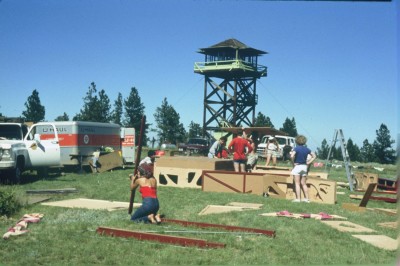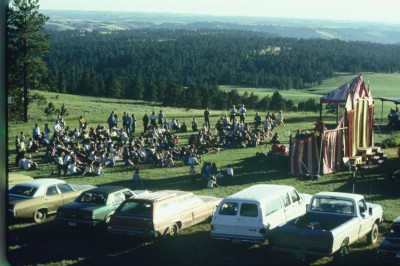
Great Performances in the Great Outdoors: Montana Shakespeare in the Parks Celebrates 50 Years
Enjoying the great outdoors on a Montana summer day means being prepared for anything. It might rain with the sun shining, hail on your mountain hike, or gust high winds and blow over your kayak on what you thought was a calm day. Unpredictability is a given. But communities across Montana have come to depend on one outdoor activity come rain or shine: Montana Shakespeare in the Parks, now in its 50th season.
In 1973, Montana Shakespeare in the Parks (MSIP) started as a small MSU outreach program for Bozeman and seven neighboring towns. The goal was to share Shakespeare with everyone—the immortal stories of life, love and tragedy—by providing lively entertainment evoking smiles and laughter, alongside tears of joy and sorrow. Performers worked tirelessly to connect people, communities and the arts, as they spread messages of unity and understanding, all under the big and unpredictable sky.
Who could have imagined then that what began as an amateur acting company, founded by Dr. Bruce Jacobsen and comprised of a mixture of students and community members, would go on to perform over 2,250 times to nearly three quarters of a million people? Or that it would be named recipient of the Governor’s Arts Award, the highest honor that can be bestowed on an arts organization in our state? Montana Shakespeare in the Parks’ contribution to the cultural fabric of Montana is undeniable.
It’s the company’s unique ability to perform Shakespeare outdoors in some of the most remote rural areas of the region—to manage those specific joys and challenges—that’s truly fascinating. It’s also the undying community support that Kevin Brustuen recalls in his article “Shakespeare’s Complete Works 50 Years of MSIP” (Bozeman Magazine, December 2021) when he attended a performance in Fishtail:
“I wondered if I might be among the very few who would come out to see this performance in the park, considering the heat and the remoteness of this place. But with little warning, several motorcycles roared past, cars came out of nowhere, and a steady flow of people arrived, blankets and chairs under their arms, until the green park was filled from front to back and from side to side with people shoulder to shoulder, eager and excited to see the famous Montana Shakespeare in the Parks.”
All theatre performances have the ability to be social, fun and entertaining, drawing you into another place and time, taking you away from the chores of the everyday. And outdoor theatre is even better. Maybe it’s the added smells and sounds of a warm summer night, the freedom to enjoy it with your family including kids and pets that need to move around; or maybe it’s simply being somewhere unexpected, beautiful and perhaps even quirky that makes you feel so much more engaged and adds an extra sense of escapism.

Outdoor theatre has been around since the 10th century. Early performances appeared at church services where stories from the Bible were dramatized for congregations who often could not read. In the 13th and 14th centuries, these performances were divorced from the church and traveled by wooden carts through the streets attempting to gather enough audience to stop and perform. Toward the end of the 15th century, many towns and cities had designated outdoor spaces for theatre performances. Some went as far as to build purpose-driven outdoor theatres such as the Globe, built in 1576. This theatre had its very own playwright, a Mr. William Shakespeare. It’s here that Shakespeare wrote many of the works we continue to enjoy today—all with the intention of seeing them performed in the outdoor arena.
The nature of outdoor theatre promotes a great relationship between actor and audience. Actors can wander through the crowd and encourage interaction and participation. That challenge to connect to all types of audience members in all types of settings draws actors to the outdoor stage.
Actor Bill Pullman, who during a talk with Anne Reiss (executive producer of the Princeton Rep Shakespeare Festival in 2003), reflected on his own experiences doing free outdoor performances of Shakespeare in Montana. One performance of special significance took place in Birney, in the middle of the Northern Cheyenne Indian Reservation. The community wanted the MSIP to set up on top of Poker Jim Butte, 10 miles into a national forest in the middle of nowhere.
Pullman described it like this: “It’s a really strange and unique blend of people you get when you’re in an outdoor Shakespeare situation. And there’s nothing more magical than having the elements around you, that challenge of having wind, rain, traffic and barking dogs. On top of Poker Jim Butte, you can see sometimes as many as three or four weather fronts operating at the same time because you can see hundreds of miles from there. And so you have that kind of excitement of being outdoors and feeling there’s some wind coming on and maybe we’re gonna have to make some changes if the rain front comes.”
He continues: “[The company manager] will try to be poker-faced as long as possible, ‘Come on. Keep going, keep going. It’s not gonna rain.’ You have your ‘shaman of denial’ who does the same kind of dance. And then there’s always that moment where they go, ‘It’s not gonna rain.’ And then they go: ‘OK. Rain speed.’ Which to that company means: double-time. You’ve got to continue doing everything you’ve been doing physically, but verbally the play has to go now twice as fast so that you can beat the storm system.”
Pullman says he learned a lot from those practices and the challenge of being outside. After a 15-year career in film and television, he met with Edward Albee (director of The Goat), to discuss his role. The director expressed some concerns regarding a film and television actor’s ability to project, which Pullman describes as “more than just speaking loudly. It’s how you make meaning tell the story...with your physical instrument in that kind of environment, when you’ve got people sometimes two hundred feet away, you’ve got to project to that back row.”
At the point when Pullman realized Albee was worried about his performance ability, he thought, “I wish they’d been on top of Poker Jim Butte. The acoustics are challenging there.”
Braving the elements and embracing the unexpected is definitely part of the charm of outdoor theatre and maybe the reason Montanans love it so much. It’s the simple act of overcoming those challenges that bring us so much joy in life. And Montana Shakespeare in the Parks has been providing that joy for the past 50 years. Their 2022 summer tour begins with performances at MSU’s Duck Pond of King Lear, June 15-18 and Twelfth Night, June 22-25. They then take the two shows on the road starting June 26, performing in approximately 56 communities in less than three months, closing in early September. In addition, MSIP will be returning to Bozeman, where it all began, for a 50th anniversary party scheduled for Aug. 6.
For more information and details about these events please visit shakespeareintheparks.org.
To subscribe to State of the Arts, click here.
Tags: shakespeare, theater, shakespeare in the parks, theatre, bard, acting and play